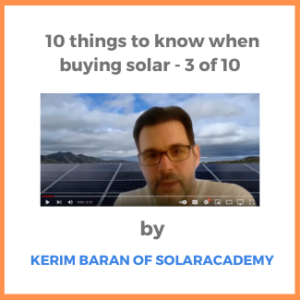In this third video in a ten-part training series of key concepts for people looking to buy a solar system, Kerim Baran of SolarAcademy digs into some key terms and concepts about solar: power and energy and how they are measured. He discusses the difference between watt and watt-hours and how the concepts relate to solar panels and energy generation. The 2.5-minute video and transcript are below. The entire series can be viewed here.
Here is the video transcript:
Kerim Baran of SolarAcademy: The third concept to understand when going solar is the concept of power and energy. Now most of us are familiar with power from just looking at a light bulb that is maybe 100-watts or 50-watts. Well, actually these older light bulbs used to have numbers like that. Now the LED light bulbs are much lower in wattage – you’re likely to find 5 watts or 10-watts of light bulbs but if you have a big powerful computer it might have a 500-watt power supply or a small laptop computer might have a 100-watt power supply.
So what that means is that that’s the power that is required to run those appliances. Then there’s the concept of energy which is measured in what hours. So if you, for example, light a 100-watt light bulb or run a 100-watt laptop for a full hour that appliance will consume 100-watt hours of energy. If you run them for 10 hours that will be 1000 watt-hours of energy that is required to run those appliances. 1000 watt-hours is also referred to as one kilowatt an hour. So that is the difference between watt and watt-hours power and energy.
Now also solar panels follow a similar logic. Let’s say a standard 400-watt solar panel if you lay that under the sun directly, ideally facing slightly south in the northern hemisphere and you let that panel produce energy under the sun for a full hour a 400-watt solar panel will generally generate 400 watt-hours of energy. Of course, there are some efficiency losses and so forth and we will talk about that in the next concept. The next concept is the solar production factor and the solar resource.
